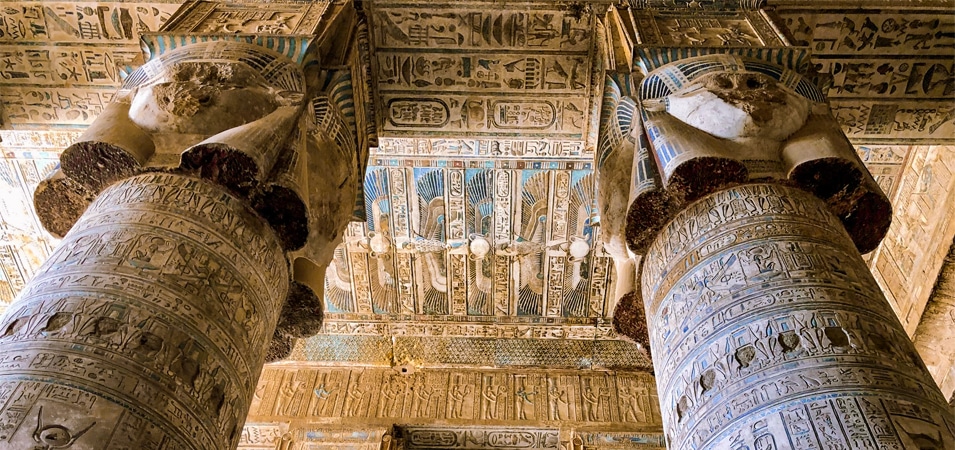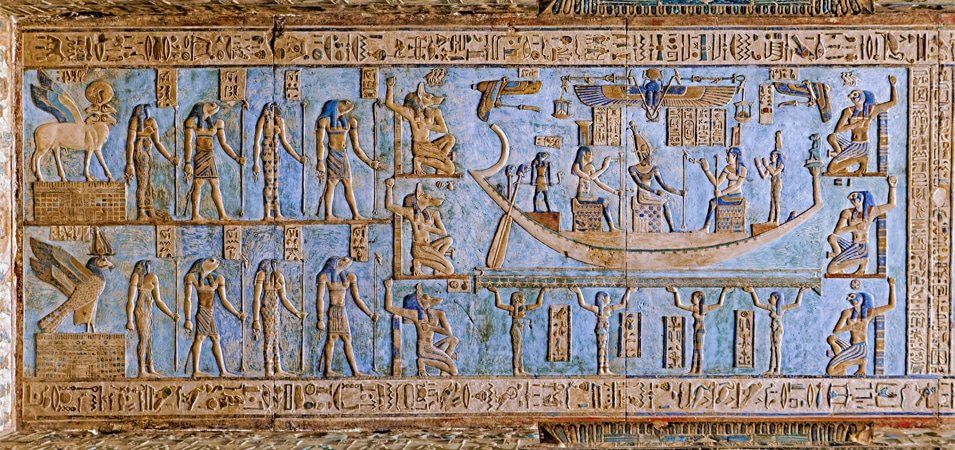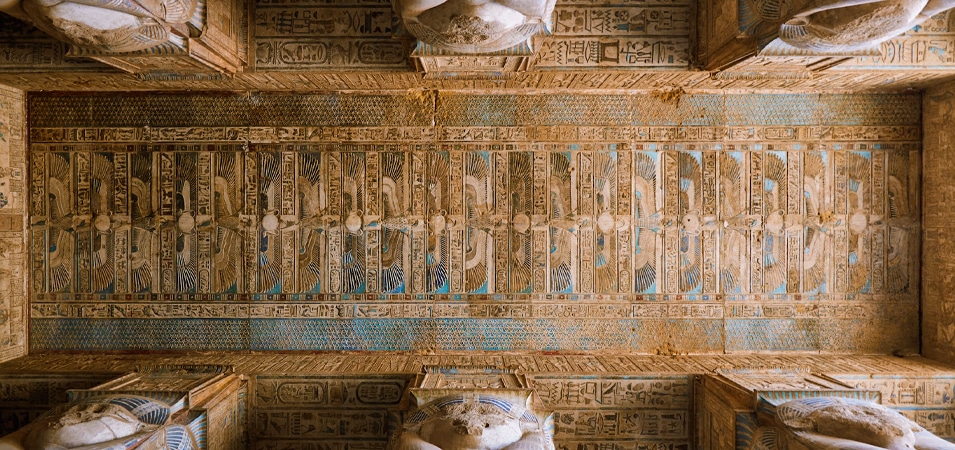Welcome to the exciting world of Egypt’s Dendera Temple, a fascinating archaeological site. This beautiful temple complex has been fascinating to historians, archaeologists, and tourists for hundreds of years. It is known for its fantastic building and intricate carvings. In this piece, we’ll learn more about the Dendera Temple’s long history, religious meaning, and mysterious parts.
Book Our Egypt Vacation Packages
The History of Dendera Temple
The Dendera Temple, also called the Temple of Hathor, has a long past that goes back to around 300 BCE when ancient Egypt was in the Ptolemaic period. But it is even more important because it is thought to have been a holy place since the Old Kingdom, from 2686 to 2181 BCE. Several pharaohs helped build and expand it over many centuries. The temple is a great example of ancient Egypt’s cultural and building achievements. Its majesty, and intricate carvings draw people in. It is an important part of Egypt’s history because it keeps the secrets of a long-ago time. Several pharaohs helped build and expand the temple over many years, so it has a unique mix of building styles.

Architecture and Design of Dendera Temple
The design and building of the Dendera Temple are unique, showing how skilled and creative ancient Egyptian builders were. Because it was built during the Hellenistic time, the temple has a unique mix of traditional Egyptian designs and Hellenistic elements. The main temple, which is for the goddess Hathor, is in the middle of the temple complex. It has vast columns with elaborate hieroglyphic carvings and brightly colored painted reliefs. The columns, which resemble papyrus plants, represent growth and new life. The temple walls are decorated with intricate friezes that show scenes from mythology, religious ceremonies, and the mighty gods of ancient Egypt. These paintings tell us a lot about what the ancient Egyptians believed, how they lived, and what they did daily. A beautiful stone gate called the tower stands at the entrance to the temple.
The pylon has huge statues and intricate details that invite people into the holy area. The design of the Dendera building goes beyond just the main building. Around the main building are many churches, courtyards, and other buildings. These include the Birth House, where the godly birth of Hathor was celebrated, and the Mammisi, a church dedicated to the birth of the pharaoh. The design of it combines holy symbols and practical concerns in a way that works well. The way the temple is set up lets the sun shine on certain places during critical astronomical events, like when certain constellations line up. Overall, the building and design of Dendera Temple are a fantastic mix of art, faith, and technical skill. It still amazes and inspires people, showing how the old Egyptian culture lives.
Don’t Miss To Read our articles about :
- 10 Things That Will Surprise You About Traveling To Egypt
- Best Places to Visit in Luxor and Aswan
- Exploring the Magic of Christmas in Egypt: A Guide for Travelers
- Gifts to Buy From Egypt: Unveiling the Treasures of Ancient Craftsmanship
- The Best Places to Visit in Egypt: Unraveling the Riches of Ancient Civilization
- Tips for the Best Nile Cruises in Egypt Christmas
The Temple Complex
The Dendera Temple is not just one building. Instead, it is a large complex with many facilities, gardens, and chapels. The center of the complex is the main temple, a shrine to the goddess Hathor. As people enter the sacred area, they are drawn in by its size and complexity. Around the main temple are some smaller buildings that serve different functions. These include the Birth House, where the godly birth of Hathor was celebrated, and the Sacred Lake, an essential part of ancient Egyptian religious rites. The Mammisi, a birth chapel, and the Hathor Chapel, which is for the goddess herself, are also essential parts of the temple complex. These buildings tell us more about how the ancient Egyptians worshipped and their beliefs. The temple building has courtyards that can be used for gatherings, ceremonies, and processions. They were significant for making it easier for priests, followers, and the gods to talk to each other.

Religious Significance of Dendera Temple
Hathor was the most important god at this Temple, a goddess of love, fertility, and happiness. People visited the temple to pray for her blessings and participate in traditions. The temple was also a big part of the yearly Hathor Festival, where priests and priestesses held religious events and put on shows for worshippers.
Dendera Light Bulb Theory
One of the most exciting things about Dendera Temple is the disputed “Dendera Light Bulb Theory.” The carvings on the walls of the building show an advanced form of lighting. But this idea is still just a guess, and scholars have had a lot to say about it. Instead of being proof of old electricity, the carvings could be symbols or parts of rituals.
Unraveling the Zodiac Ceiling
The Zodiac Ceiling is one of the most well-known parts of the Dendera Temple. This ceiling is drawn in a very detailed way. It shows the constellations of the zodiac as well as different mythological figures and astronomical symbols. Experts are amazed by how accurate the zodiac pictures are, which gives us important information about ancient Egyptian science and cosmology.
Don’t Miss To Read our articles about :
- Discover Egypt’s Holy Family Trail: Unveiling Sacred Destinations
- Discover Egypt’s Ramadan: Customs and Celebrations
- Ultimate Guide: Planning a Trip to Egypt – Top Tips & Attractions
- Discover Egypt’s Stunning National Parks: Nature’s Beauty
The Crypts and Hidden Chambers
Under the surface of Dendera Temple, archaeologists have found secret tombs and hidden rooms. These underground tunnels were used for holy ceremonies and graves. Archaeologists have found beautifully decorated sarcophagi, mummified bodies, and valuable items. These things tell us about the ancient Egyptians’ funeral practices and beliefs.
Restoration Efforts of Dendera Temple
Over the years, Dendera Temple has had a lot of work done to keep it looking beautiful. Restoration teams have carefully fixed broken parts, stabilized delicate carvings, and ensured the temple complex is stable. Because of these attempts, people can now see how beautiful this Temple is.

Visiting Dendera Temple Today
Even now, Dendera Temple is a famous place for tourists interested in history and spirituality or just curious. People can walk around the vast complex, look at the impressive columns and reliefs, and get lost in the mysterious atmosphere of this old holy site. Guides with a lot of experience explain the temple’s history, mythology, and architectural importance, which makes the trip much more enjoyable.
Conclusion
The Dendera Temple is a great example of what the ancient Egyptians were able to accomplish. It’s an incredible building. Intricate carvings and religious symbols continue to capture our attention. As we look around this holy place, we are reminded of how wise and talented our old ancestors were. Dendera Temple gives us a glimpse of a time gone by and reminds us of the lasting effects of the past. Suppose you love history or are just interested in the things that happened in the past. In that case, a trip to the Dendera Temple will take you on an unforgettable journey into the heart of Egypt’s rich cultural history. So, pack your bags and go on a journey to discover the secrets of Dendera Temple.
FAQs
Can I take photographs inside Dendera Temple?
Yes, you can take pictures in the temple area. On the other hand, tripods and other expert tools may need special permission.
How long does it take to explore Dendera Temple?
The duration you stay depends on how interested you are. Most people spend between 2 and 3 hours looking around the temple complex.
Are there any entrance fees to visit Dendera Temple?
Yes, you have to pay to get into Dendera Temple. The price is different for Egyptians and people from other countries.
Is Dendera Temple accessible for people with disabilities?
Even though there have been attempts to make the temple complex more accessible, some parts may be hard for people with mobility issues to get to.
Are there any nearby accommodations for visitors?
There are several hotels and resorts in the nearby city of Luxor, making it easy to visit the area’s Dendera Temple and other historical sites.
